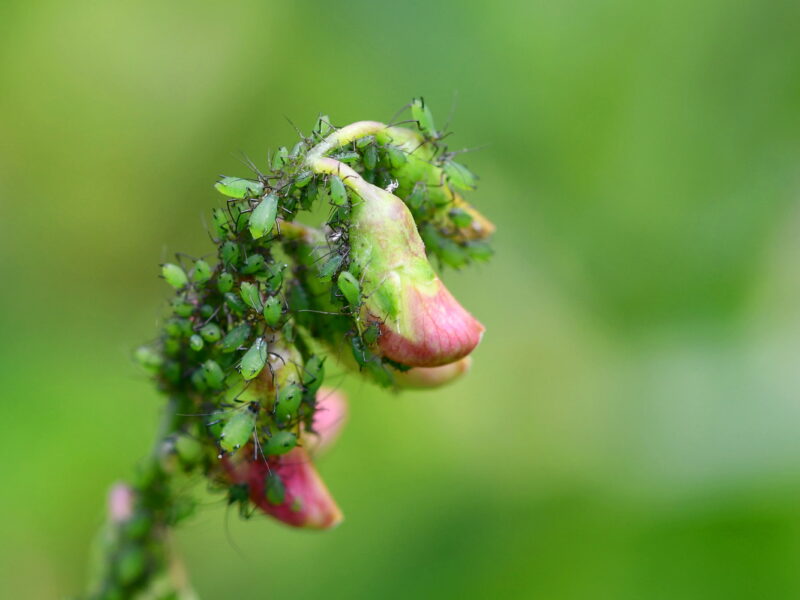

Nancy is a gardener who has been working in my garden for more than a decade.
She was working in the long border on a cold May morning when she yelled over to me, “I got two.” From her position in the garden, I knew immediately she meant. She’d spotted two SLB’s, or scarlet lily beetles. The new bane of my existence. As I got closer she asked, “Should I squish them?” I replied with a resounding “YES!”
I’d been seeing an occasional SLB for weeks on the fritillarias, and now they’d moved over to the lilies and the war was on. Having seen the adults and even a pair copulating I knew the battle had begun. It meant examining the underside of the lily foliage, and sure enough Nancy found the telltale inch-long line of five eggs on the underside of a leaf. The SLB’s had begun reproducing. Easy enough to just wipe them off, but miss just one adult female or a string of five eggs and the battle heightens.
So began my seasonal battle with the bugs — insects of all kinds that by their nature want to chew the foliage of my ornamentals, suck the sap, devour the flowers. I’m ready, but I absolutely have to stay vigilant and have my tools and sprays available, but the most important of all the tools is knowledge. The knowledge of what bugs I need to do battle with, what they do and the least environmentally damaging method of control.
I’m old enough to remember a time when gardeners would find an insect issue in their garden and, without knowing anything about the insect, get out the bottle of insecticide (or bag, as back then many insecticides were only available as powders that needed to be mixed with water). Everything got sprayed, as obviously the insect was everywhere. But it wasn’t.
The result was mass destruction. Yes, the insect was probably killed, but so was every other insect in the landscape. In a week or so the insects would return. More spraying. It wasn’t uncommon for spraying to be done every week to 10 days. After all, that’s what the label suggested. The gardener was wrong. The instructions were wrong. The whole approach was wrong.
Today, the environmentally sensitive pest control approach is very, very different. First, identify the pest. Second, determine what the pest is doing. Third, determine the most effective method of control. When your first response is to drop an atomic bomb on the garden to control some ants, you’ve made two serious mistakes. First, you didn’t do your homework to find out what damage the ants were doing. On plants the ants are usually an indicator of a secondary problem, and the ants, in fact, aren’t bothering the plant. Killing the ants in this case is ineffectual.
The ants in this situation are actually after a very sweet and sticky substance that we call honeydew. The honeydew is the excretion of another insect, in this case the green peach aphid, one of the most common garden insects and one you can probably find now on fruit trees and roses.
OK, so we realize from looking closer at the plants, in this case several rose plants, that each new rose bud has a few or many hourglass-shaped insects on the buds. Aphids fall into one of two groups that we loosely put insects into, and they belong to the sucking group. They have needle-like mouthparts that they shove into the plant cells or vascular system, and they suck the plants “juices.” When a colony of aphids gets large enough on a rose bud you can see them move almost in unison as you get close to them. They are what we call “social” insects in that they form groups, social groups, that feed en masse.
Aphids feeding on plants does more than cause a bud or flower to deteriorate. These aphids can also carry diseases, including viruses. As they insert their needle-like mouthparts into the plant tissue they transmit the disease. So, in the case of the green peach aphid, controlling aphids also means controlling the diseases they may carry. But how do you get rid of the aphids?
On roses, when you see one or two aphids, a simple strong spray of water will wash them off. That would be the least environmentally invasive way to start, and in insect control we always look at the least damaging method first. Now, you don’t want to get your rose foliage wet and let it stay wet; this can also lead to or exacerbate disease issues. So for large numbers of aphids on roses we look for another control method, still trying to stay away from stronger and unnecessary insecticides.
You could use a chemical like Sevin, but in your reading you’ve found that Sevin is highly toxic to bees and is fairly nonselective. This is, it kills most insects, not just the aphids. Yes, there are insects that are very beneficial, and chemicals like Sevin, once commonly used on roses, don’t differentiate between the good bugs and the bad ones. Sevin is also a “persistent” insecticide that can last in the garden (the environment) for months and months, continuing to do its damage, even to us.
So you pass on Sevin and other chemical-based insecticides because you remember reading (in this column) about horticultural oils. This sub-group of insecticides, when properly used, does not persist and doesn’t kill insects by poisoning their brains or digestive systems. Oils kill insects by a mechanical action not a chemical action. The oil covers an insect’s body. Insects “breathe” through their bodies, and when the oil coats an insect, it can’t breathe. The insect dies with little to no environmental backlash.
For decades we’ve been using horticultural oils on our fruit trees. Originally these oils were heavy, hard to use and were only used when fruit trees were dormant. The oils smothered any insect eggs or coated scale insects, robbing them of air to breath. But these oils could only be used when the trees were dormant and not once the flowers were opening.
Now we have new oils that are referred to as highly refined horticultural oils. They are thin, light, and unlike the early oils, these oils can be used year-round so long as you don’t use them on hot (over 80 degrees or so) sunny days.
I’ve been using a Bonide product called “All Seasons” horticultural oil, which is a mineral oil, but there are also some that are vegetable based. They all work the same way, by smothering the “target” insect, and can be highly effective. But as with any insecticide, you need to read the label as it will have dilution rates as well as cautions on what plants and insects it’s effective on.
Hort oils can also have a very important secondary effect. Since they have a smothering effect, they can often smother and shut down many disease organisms that spread by spores, since the spores are smothered. This can be a very helpful side benefit on plants like roses and fruits, but the oils will not have any effect on plant viruses other than killing the insects like aphids that can transmit the virus.
The downside to hort oils is that they have no residual effects, and you may need to make more than one application to get good control. Some plants are sensitive to these oils. The oils should never be used on hot sunny days as they can damage plants as it gets warmer. As tiny as the print is on the label, make sure you read the label and the cautions.
Other cautions on hort oils is that they can damage the foliage plants that have “hairy” or gray foliage. This would include artemisias, which are popular seaside annuals and perennials, and they may also cause slight damage on some succulents. But the succulents in the garden, like sedums, rarely if ever need to be sprayed for insects. These oils can also damage open flowers so keep your spray on the buds and stems.
Next week we’ll take a look at some other low-toxicity insecticides and other insects that can be a problem. For now, look for aphids on your roses and fruit trees.
Remember that mites, like the two-spotted spider mites and other mites that love privet hedges, are not true insects. One clue is that they have eight legs and not six like true insects. Light hort oils will also work on the mites due to its smothering effect and not poisonous mode of action. Keep growing.
GARDEN NOTES
And as I sit in my office finishing up this week’s column I look out the window at the birch tree 10 feet away and see a pair of black-capped chickadees scouring the tree from top to bottom pecking at the undersides of the foliage. I walk out and begin to examine the leaves and sure enough the birds have been feeding on aphids, who in turn are feeding on the leaves as they extract their meal. Ahh, nature. There always seems to be one thing that will eat another — unless we kill them. These tiny birds will keep the aphids under control. Good enough for me.
 More Posts from Andrew Messinger
More Posts from Andrew Messinger